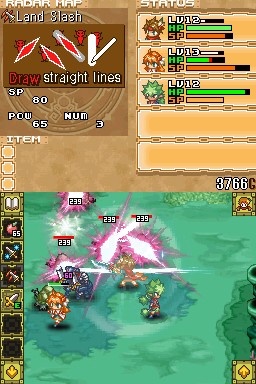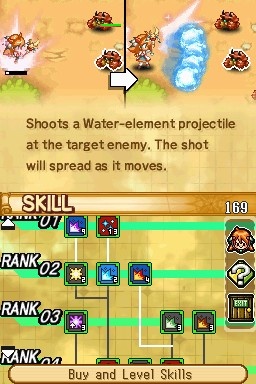Summon Night: Twin Age Hands-On
We cast some spells and bash some monsters in Atlus' upcoming action role-playing game for the DS.
Though the Summon Night series made its debut on the original PlayStation in Japan back in 2000, it wasn't until Summon Night: Swordcraft Story was released roughly two years ago for the Game Boy Advance that its games finally began to make their way overseas. Following in the tradition of its immediate predecessors, Summon Night: Twin Age is an action role-playing game on a portable platform, but that's about where the similarities end. We recently had the opportunity to take this new Diablo-style game for a test drive and are quite pleased with how it's shaping up.
In the world of Clardona, all natural phenomena, such as wind and fire, is generated by spirits from another world. The beastlike Kascuza believe in working together with these spirits, while the humans prefer to force them to do their bidding through their summoning abilities. This disparate philosophical difference has spurred the two races to war, though the fighting has yet to reach the island of Jarazi where the young human Reiha and her younger brother Aldo live peacefully among the Kascuza. But all is not well because something drives the spirits mad and the two must depart from their home to discover the source of corruption in their world.

Twin Age is an action RPG, but this iteration is much different from its forerunners, which featured random encounters and a side-scrolling combat system similar to the one found in the Tales series. In Twin Age, monsters roam about freely to be engaged or snuck around at will, and all aspects of the game are controlled in real time through the touch screen. Using the stylus, you direct both Reiha and Aldo through dungeons by tapping the location you want them to move toward or holding down to make them run in that direction. Though you only command one sibling at a time, swapping characters is as easy as tapping one corner of the screen. The AI that takes over for your partner is also responsive and useful. Melee combat is as simple to initiate as tapping an enemy, but depending on the situation, that may not always be how you'll want to handle things. Both of your characters are handled in vastly different ways, but the one thing they have in common is the host of powerful attacks that they unleash.
Reiha is an all-purpose spellcaster who can unleash the elements upon her enemies. Each spell she casts is performed by manipulating the stylus and affects monsters in different ways. For example, to cast flame burst, you draw a short line in any shape, which becomes a towering inferno that deals incredible damage over time to anything unfortunate to be caught within it. Spark shot, on the other hand, creates an arrow out of air that can pierce through multiple enemies and is cast by tapping a single target. Aldo is a powerful warrior who specializes in attacks of the more up-close-and-personal variety. His chain attack ability causes him to bum-rush a series of foes as dictated by quick taps of the stylus, while his land slash ability lets you draw straight lines across the screen that turn into powerful slashes.
Key to activating these abilities is the command palette, which is a panel of programmable shortcuts. You simply decide which abilities you want to have available at any given time in your menu system and change them out as necessary. You also have a panel dedicated to items, and it's always handy to have a banna yogurt handy for when you need some extra health.
As Reiha and her brother level up, they gain skill points, which can be spent while on the map screen to power up existing spells and abilities. This is all done through an elaborate skill-tree system, and as long as you've met the necessary requirements, you can expand your knowledge to learn entirely new powers. For example, Reiha can learn restorative abilities, while Aldo can become proficient in axes and spears to learn attacks that are specific to those weapons.

Much of the gameplay is spent dungeon-crawling as the siblings travel from one area to the next in search of the truth. Along the way, they will be joined by friends that fight alongside them, though there can only be a single active ally at a time, and he or she is always computer controlled. Danger is to be found at every turn, but save points aren't hard to come by, and helpful items are easily found by breaking open the crates or jars that appear everywhere. Occasionally, you're presented with titanic boss battles, which are always the most challenging and rewarding encounters to be found.
Twin Age features a brightly colored anime art style. The environments and monsters--especially the bosses--are quite imaginative. Character sprites are well animated, as are spells and attacks. Though most of the dialogue is text-only, there is some English voice-over work that pops up occasionally. The music is also appropriately ambient and fitting.
Summon Night: Twin Age will be coming out in the US on May 20. Be sure to check back at that time for our final opinion and review.
Got a news tip or want to contact us directly? Email news@gamespot.com
Join the conversation